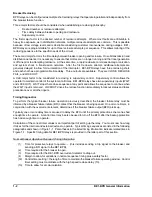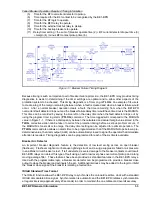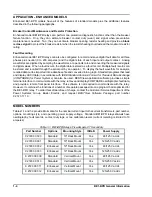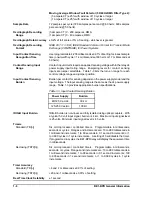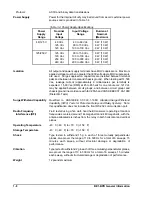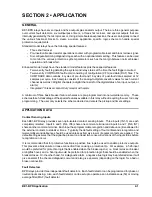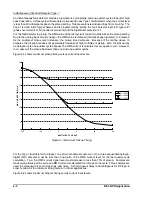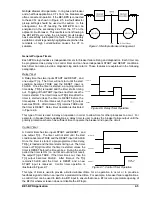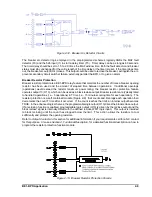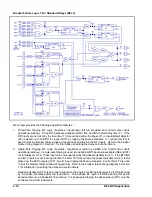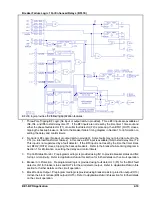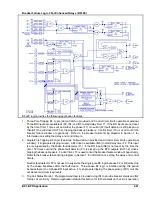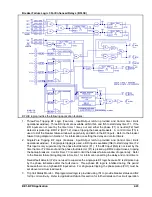
2-8
BE1-BPR Application
5 2 a
N
P
T
B F I
or
6 2 X
T C M
+
V
-
+
V
-
8 6
B r e a k e r
R e t r i p
O 5
IOIT
2 1
IN 2 ( T C M )
Trip Ckt 1
S e n s e
P
T
5 2 a
5 2 T C 1
N
6 2 X
a. Schematic Diagram
b. Equivalent Voltage
Divider Circuit
D2822-09
08-07-98
Figure 2-11. Trip Circuit Monitor With BFI Sensing
Figure 2-11 illustrates a problem that can occur when using the trip circuit monitor feature. If the breaker
failure initiate (BFI) sensing is connected directly to the breaker trip bus as shown in Figure 2-11a, the
equivalent circuit shown in Figure 2-11b occurs. If the diode of the circuit is not included, a voltage divider
circuit will be created between the BFI sensing and the TCM sensing when the 52a contact or the trip coil
is open.
In Figure 2-11a, a 62x BFI auxiliary relay is shown. In this case, the impedance of the 62x coil will be small
compared to the impedance of the TCM circuit so the TCM will always be at logic 1. This will prevent the
TCM logic from working, even if the trip coil is open. In the case that the high impedance BFI sensing input
of the BE1-BPR is connected directly to the trip bus, the TCM and the BFI impedances will be of similar
magnitude causing the voltage to be divided nearly equally. This can result in spurious BFI signals to the
breaker failure protection scheme when the breaker is open. Normally, when redundant systems are used,
each relay system will be on its own circuit and the BFI sensing for each relay system will be isolated from
the tripping circuit so this is not a problem.
Breaker Arc Detector
Once a breaker is open, an arc or flashover from a lightning strike may occur if the surge suppressors fail
or air pressure is lost in an airblast circuit breaker. If this arc is not extinguished, the breaker can be
damaged or destroyed. If the breaker was opened due to a fault on the line, then protective relays on the
line will operate. If the line is not cleared, the relay logic will trip the backup breakers to clear the line and
save the breaker.
If both ends of the line are open with no fault, then the breaker may just be carrying low level, line charging
current. This current will not operate the protective relays because it is well below the normal loading levels.
However, it is enough to destroy the breaker if not cleared. To provide protection for this situation, a very
sensitive fault detector is needed that operates at line charging current levels and is only enabled when the
breaker is open. When the fault is detected, the arc can be cleared by reclosing the breaker or operating
backup protection for breaker failures. Reclosing will not affect safety of personnel if normal working
practices are followed to disconnect any sections of the line being worked on (the line would be energized
by the arc in any case). If the breaker reclosed into a faulted line, the normal protection devices would
immediately re-open the line.
The BE1-BPR relay has a sensitive low level pickup for this application (MAF fault detector). Figure 2-12
shows the breaker arc detector circuits with the three-phase MAF fault detector (F3). It is easy to inhibit the
relay based on the breaker status by programming the relay logic. As discussed previously in the fault
detector application paragraphs, the MAF fault detector filter is slow to pickup and dropout. Therefore, the
fault detector response must be delayed to allow time for normal load or fault current to clear the filter section.
For example, if a 60 cycle MAF fault detector is used and set at 0.1 ampere (below line charging current
levels), then the MAF fault detector remains picked-up for 1 second after the breaker opens because it takes
that long for the filter buffer to clear. Therefore, the MAF fault detector output must be delayed for a time
longer than the filter length to ensure that only a sustained current signal causes an output. This delay time
could be 20 to 30 seconds longer.
Summary of Contents for BE1-BPR
Page 31: ...BE1 BPR Application 2 17...
Page 42: ...3 4 BE1 BPR Human Machine Interface Figure 3 4 BE1 BPR Relay Vertical Mount Front View...
Page 43: ...BE1 BPR Human Machine Interface 3 5 Figure 3 5 BE1 BPR Relay Vertical Mount Rear View...
Page 49: ...4 6 BE1 BPR Functional Description Figure 4 2 Enhanced BE1 BPR Menu Display Screens...
Page 50: ...BE1 BPR Functional Description 4 7 Figure 4 3 Standard BE1 BPR Menu Display Screens...
Page 94: ...5 4 BE1 BPR BESTlogic Figure 5 1 BESTlogic Function Blocks...
Page 121: ...BE1 BPR Installation 7 3 Figure 7 3 Overall Dimensions Vertical Mount...
Page 122: ...7 4 BE1 BPR Installation Figure 7 4 Overall Dimensions Side View Vertical Mount...
Page 123: ...BE1 BPR Installation 7 5 Figure 7 5 Panel Drilling Diagram Vertical Mount...

